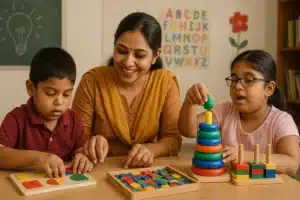
Source: onlymyhealth
Remediation Math is a focused program designed to help students who are struggling to grasp essential math skills and concepts. It offers focused, brief assistance to enhance mathematical reasoning and computation through small group sessions or individualized teaching.
Teachers of remediation math are experts who customize their classes to fit the individual needs of each student, giving them the self-assurance and skills they need to succeed at their grade level. Students leave the program once they reach this degree of independence, but their progress is continuously tracked to ensure their academic achievement.
How Do You Remediate Math?
Remediation Math effectively involves using targeted strategies to help students better understand math concepts and processes. By addressing each student’s unique needs, teachers can ensure that they grasp the essential skills needed for success.
For educators looking to enhance their ability to Remediation Math, Vidhyanidhi Education Society (Govt. Regd.) offers a Remedial Course that equips teachers with critical skills.
Here are some proven strategies to remediate math, along with examples:
Teach the logic
Explain the reasoning behind concepts rather than just teaching formulas. If you want to explain multiplication to a child, also co-relate it to addition, which helps them understand the common relationship between addition and maths.
For e.g. 3*2 =6 and 3+3= 6
Review regularly
Go over concepts repeatedly to ensure retention. For example, revisiting fractions throughout the year helps students retain their understanding, rather than moving on too quickly to new topics.
Encourage verbalization
Ask students to explain their thought process.
Use a lot of oral instructions while solving problems. E.g. when teaching division 15 ÷ 5 make it clear to you the student that you will be dividing the number 15 in 5 equal parts so each part will have 3.
Use real objects
Using real-life objects that the child can relate to such as blocks, or fraction bars can make abstract ideas more concrete. When teaching fractions, using fraction circles or examples of things known well to them like Pizzas, clocks can help students visualize how parts make up a whole.
Highlight connections
Help students see how different math concepts are related. For example, show how learning multiplication helps with division by explaining that if 3 × 4 = 12, then 12 ÷ 4 = 3.
Reduce emphasis on speed
Early on, focus on understanding, not speed. Instead of timing students on math facts, focus on whether they understand why 5 + 3 equals 8.
Develop math vocabulary
Create a word wall of terms like “denominator” and “quotient,” or encourage students to keep a math dictionary. This helps students build familiarity with terms and apply them correctly.
Use graphic organizers
Tools like Frayer boards can help students break down math vocabulary by defining terms, showing examples, and visualizing relationships. For example, students could use a Frayer board to explore the concept of “perimeter.”
Just-in-time review
Review key topics as they come up in the current curriculum. If teaching geometry, for instance, revisit earlier lessons on shapes and angles as needed to reinforce understanding.
Consider changing understanding
Monitor how students’ understanding evolves. A student may initially struggle with decimals but show improvement after reviewing place value again.
Incorporate digital learning
Personalized learning platforms, like math apps, can offer interactive practice tailored to the student’s needs. For example, apps that adjust difficulty levels based on the student’s progress can support math remediation effectively.
By mastering these techniques, teachers can provide targeted and effective support, helping students overcome their challenges in math and succeed in their academic journey.

Source: teflcourse
Remediation Lesson Plans For Math
Remediation Lesson Plans for Math can work wonders for the child as the basic concepts that are taught can be reinforced well helping children gain a clear and precise understanding of important concepts. Once the concepts are grasped properly the child builds a strong foundation in Remediation Math which makes the further learning process easy.
Remediation Plans help ensure that the child is at par with the rest of his counterparts and that any kind of academic gap is taken care of.
Here are some key steps to consider when developing Remediation Lesson Plans for Math:
Questions to Ask Yourself
Analysing before teaching is a crucial step in initiating a remediation plan. Before starting, ask yourself important questions like: What specific math skills are students struggling with? What are their current levels of understanding? Which are the most likely workable interventions with a higher success percentage? With a clear vision customizing lesson plans can be simple ensuring that the learning goals are achieved.
Lesson Plans For Math Should Start with a Plan
Begin each session with a clear, step-by-step plan. For example, if you are reteaching fractions, outline specific goals like understanding numerator and denominator, recognizing equivalent fractions, and performing basic operations with fractions. Having a clear roadmap keeps the lesson focused and ensures that you cover all essential areas.
Have an Online Lesson Template
Using an online lesson template can streamline your planning process and provide a structured format for your lessons. Templates can include sections like objectives, materials needed, assessment methods, and feedback opportunities. Having a consistent structure saves time and ensures you do not overlook key elements.
Be Prepared
Preparation is key for successful remediation. Make sure to gather any materials you will need, such as manipulatives, worksheets, or digital tools. For a particular lesson, you need to display any visual aid and keep it ready before starting the lesson to avoid wasting time and maintain great flow in the lesson.
Ask for Feedback
Encourage students to give their honest opinions about how the lesson was conducted, and what could be done in a better way for enhancing the learning. Regular feedback helps teachers improve their lesson plans and opt for proven teaching strategies that align with the learning objectives of the child.
Contemplate
Once a lesson is completed spend some time contemplating about how you conducted the lesson regarding its effectiveness. Reflect on some important questions such as where the learning goals were achieved. Did the children relate well to the teaching methods? These questions can help the teacher improve her lessons to meet her students’ needs better.
By following these steps, teachers can create thoughtful and effective Remediation Lesson Plans for Math that address students’ individual needs and support their progress in mastering mathematical concepts.
Master the art of teaching with Vidhyanidhi Education Society’s Remedial Tutor Course! Enroll today!
For more details on Remedial Tutor Course Call WhatsApp on +919321024137 or +9198699866277
To download the brochure of the Remedial Tutor Course, Click Here!
FAQs
Is Remedial Math Easy?
Remedial Math can be challenging, but with tailored support and personalized strategies, students can gradually master essential concepts at their own pace.
What is Remedial Teaching in Mathematics?
Remedial Teaching in Mathematics is focused, personalized instruction designed to help students strengthen fundamental math skills and close learning gaps effectively.
How to be a Special Educator?
To become a Remedial Tutor, gaining specialized skills in identifying and addressing student learning gaps is crucial. Vidhyanidhi Education Society offers a Remedial Course to help you.



